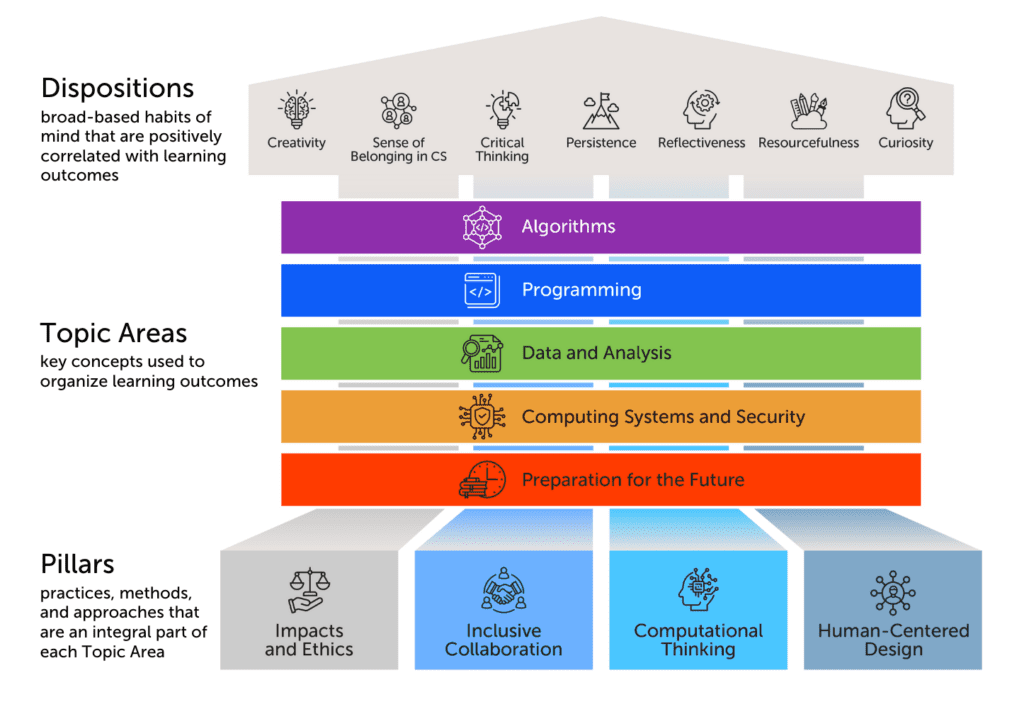By Julie M. Smith, PhD, Senior Education Researcher, Institute for Advancing Computing Education
CSTA and IACE recently facilitated a project, Reimagining CS Pathways, that had two main goals. The first goal was to develop a community consensus around what computing content all high school graduates should know; the second was to explore what pathways for continued learning could stem from that foundational content. The foundational computing content is shown in the graphic below.

The foundational content – what every student should know to be prepared for a world powered by computing – was divided into three parts: pillars, topics and dispositions. At the bottom of the graphic are pillars, including impacts and ethics, which should weave through all of the topic areas. In the middle of the graphic are the five topic areas. And, emerging from the pillars and topics are seven dispositions.
Dispositions are habits of mind and practices (Claxton, 2009) – these are usually not taught explicitly but rather develop through the process of learning about the topic areas via the pillars. The dispositions that were identified as important in computer science by a diverse group of educators and researchers are:
- Creativity
- Sense of belonging in computing
- Critical thinking
- Persistence
- Reflectiveness
- Resourcefulness
- Curiosity
These dispositions are correlated with important learning outcomes. For example, a sense of belonging in computing is one of the more extensively researched dispositions in computing education. It is linked to a student’s sense of their own ability in (Veilleux et al., 2013) and interest in persisting in (Hansen et al., 2023) studying computing. A robust sense of belonging is an important facet of ensuring equity in computing since this sense often differs by student demographic group (Krause-Levy et al., 2021). Similarly, reflectiveness – developed through activities asking a student to reflect on their experiences – has been shown to improve learning outcomes (Zarestky et al., 2022). And these dispositions are often interrelated. For example, experiences that emphasize creativity can correlate with an increased sense of belonging in computing (Ryoo & Tsui, 2023).
Interestingly, five of the dispositions (persistence, reflectiveness, curiosity, critical thinking, and resourcefulness) map to self-regulated learning (Zimmerman, 2010). Self-regulated learning is learning guided by a combination of the learner’s metacognition (thinking about one’s thinking), strategic action taken by the learner (such as planning, monitoring, and evaluating personal progress against a standard), and the learner’s motivation to learn (Butler & Winne, 1995). Self-regulated learning has been shown to improve learning outcomes across contexts (Paris & Paris, 2001; Sontag & Stoeger, 2015). Teaching activities that support self-regulated learning may include learner self-assessment, reciprocal teaching where students who learned the material teach other students, and activities that encourage learners seeking help.
The Reimagining CS Pathways project includes recommendations for how computing education experiences can be designed to provide students with opportunities to develop key dispositions. For example, a high school student learning about algorithms (a topic area) might design an algorithm to power a chat room, considering content moderation policies (incorporating impacts and ethics) and then later reflect on their personal experience in making trade-offs between privacy and transparency in the design of the system (a chance to practice reflectiveness).
Educators can help students to develop these key dispositions – regardless of curriculum used. One approach would be to reflect on how each unit taught could be adjusted to incorporate opportunities for the development of one disposition.
The development of these dispositions in students – which aid but also transcend computing – can empower them for success in a wide variety of their future pursuits.
See the full report Reimagining CS Pathways: Every Student Prepared for a World Powered by Computing for more about dispositions.

